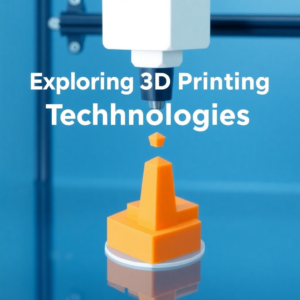Exciting 3D Printing Expected Trends for 2025

Explore the key 3D printing trends expected in 2025, including advancements in AI, new materials, sustainability, and industrial-scale applications. Stay ahead of the curve with expert insights.
3D Printing Expected Trends for 2025
As 3D printing technology continues to mature, experts are forecasting several key trends that will dominate the industry in 2025. From improved efficiency through artificial intelligence (AI) to breakthroughs in new materials and sustainable practices, the additive manufacturing (AM) landscape is rapidly evolving. This article highlights the most anticipated 3D printing trends for 2025 based on industry expert analysis.
1. Artificial Intelligence Integration for Process Optimization
The integration of AI and machine learning into 3D printing is expected to become more prominent in 2025. AI’s role in additive manufacturing is to enhance precision, reduce material waste, and optimize print speed by analyzing data in real time. Through AI algorithms, printers will adjust parameters such as temperature, speed, and material flow, ensuring optimal results and fewer errors. This will lead to greater consistency and reduced downtime in production.
Moreover, AI-powered predictive maintenance will become more common, allowing for real-time diagnostics of 3D printers. This will minimize machine failures and increase uptime across industries like aerospace, healthcare, and automotive, where reliability is crucial(ScienceDaily)
2. Breakthroughs in 3D Printing Materials
The development of new materials for 3D printing will be a critical driver of growth in 2025. Experts predict that functional materials, such as conductive polymers, biodegradable plastics, and stronger, lightweight metal alloys, will enter the market. These advancements will expand 3D printing’s applications in industries like electronics, healthcare, and sustainable manufacturing.
In the medical sector, biocompatible materials are expected to evolve further, allowing for improved 3D printing of implants, prosthetics, and even organs. Additionally, industries like construction are investing in eco-friendly, recyclable materials that can be used for large-scale infrastructure projects

3. Sustainability Will Be a Major Focus
Sustainability is set to be one of the most important trends in 2025, with more companies adopting environmentally friendly materials and processes. The ability of 3D printing to minimize waste by using only the necessary amount of material aligns with global sustainability goals. Additionally, companies are working on developing recycled filaments and biodegradable resins that will reduce the environmental impact of manufacturing.
Moreover, 3D printing’s capacity to localize production will reduce the need for long-distance shipping, thereby cutting carbon emissions. For industries like construction, where large volumes of materials are needed, 3D printing presents an opportunity to build structures more efficiently and sustainably
4. Increased Adoption of Industrial-Scale 3D Printing
By 2025, 3D printing is expected to see broader adoption in industrial-scale manufacturing. Large companies in sectors such as automotive, aerospace, and defense are investing in high-speed 3D printers capable of producing larger parts with greater precision. The focus will shift from prototyping and small-batch production to mass production, with entire assembly lines potentially relying on additive manufacturing.
Hybrid manufacturing systems that combine 3D printing with traditional processes will also gain traction, enabling companies to produce complex components that were once impossible to manufacture using conventional methods alone
5. Customization and Personalization
One of the most exciting trends for 2025 is the continued growth of customization in 3D printing. In fields like healthcare, 3D printing will enable the production of custom implants, prosthetics, and medical devices tailored to each patient’s unique anatomy. This trend will also carry over to consumer goods, with customers being able to personalize everything from clothing to furniture with designs made specifically for them
Furthermore, advancements in software and scanning technology will make it easier for companies to collect data from consumers or patients and transform that data into personalized products.
6. Multi-Material and Multi-Color Printing
By 2025, multi-material and multi-color 3D printing will become more prevalent. This trend will be driven by new technologies that allow printers to work with different materials and colors in a single print job. For example, hybrid printing methods will enable the production of complex products with multiple textures and functionalities.
This will be especially beneficial for industries like consumer electronics, medical devices, and automotive, where different material properties are needed for different parts of a product. The ability to print products with varying hardness, flexibility, and color will open new doors for innovation
The 3D printing industry is set for significant advancements in 2025. From the increased integration of AI to the development of new materials and a stronger focus on sustainability, these trends will reshape industries across the globe. As 3D printing continues to mature, we can expect to see it take on a larger role in mass production, personalized manufacturing, and eco-friendly processes. By staying ahead of these trends, companies can leverage 3D printing to innovate and grow in the coming years.
For more insights and projects continue exploring our page https://master3dp.com/



